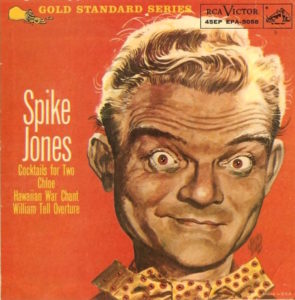In today’s Wall Street Journal “Sightings” column, I pay tribute to Spike Jones. Here’s an excerpt.
* * *
Humor and music aren’t always strange bedfellows, but they sometimes make for an uneasy fit. From Gilbert and Sullivan’s “My Object All Sublime” to Rupert Holmes’ “Escape (The Piña Colada Song),” most comic songs are in fact musically straightforward ditties that just happen to tell a funny story. Take “Weird Al” Yankovic, pop music’s clown prince of parody, whose modus operandi is to write incongruous new lyrics for familiar songs. Give a careful listen to, say, “Eat It,” his cover version of Michael Jackson’s “Beat It,” and you’ll be struck by how closely the instrumental backing reproduces that of the original record….
 The staying power of Mr. Yankovic’s formula has long since proved itself. But there are other, more specifically musical ways to make funny music. Haydn, the most sophisticated of all musical comedians, did it by spicing up the time-honored formulas of classical music with startling musical jokes, the most celebrated of which is the explosive fortissimo chord that he detonates without warning a half-minute or so into the slow movement of his “Surprise” Symphony. And a century and a half later, Spike Jones and His City Slickers, American pop music’s first great comedy band, dusted off Haydn’s bottomless bag of tricks, using them to cut dozens of records that remain wildly funny to this day….
The staying power of Mr. Yankovic’s formula has long since proved itself. But there are other, more specifically musical ways to make funny music. Haydn, the most sophisticated of all musical comedians, did it by spicing up the time-honored formulas of classical music with startling musical jokes, the most celebrated of which is the explosive fortissimo chord that he detonates without warning a half-minute or so into the slow movement of his “Surprise” Symphony. And a century and a half later, Spike Jones and His City Slickers, American pop music’s first great comedy band, dusted off Haydn’s bottomless bag of tricks, using them to cut dozens of records that remain wildly funny to this day….
One of his biggest hits, a 1942 version of “Cocktails for Two,” shows off his method (if you want to call it that) to sensational effect. The original song, written in 1934, is a sugary ballad that tells the tale of a romantic encounter “in some secluded rendezvous/That overlooks the avenue.” Accordingly, Jones’ recording starts off with a straight-down-the-center harp-accompanied vocal-group performance of the verse, one that never hints at the chaos to come. Then someone shouts “WHOOPEE!” and the rest of the band crashes in from out of nowhere with a hard-charging, Dixieland-flavored banjo-and-tuba accompaniment interspersed with such exquisitely timed sound effects as a pistol shot, a bicycle horn, a clanging fire-station bell and—least likely of all—a hoedown fiddle….
Nothing in Jones’ previous life suggested that he longed to become a specialist in musical slapstick….
* * *
Read the whole thing here.
A 1945 “soundie” film version of Spike Jones’ “Cocktails for Two”:
Spike Jones appears as the mystery guest on a 1954 episode of What’s My Line? The panel includes Steve Allen, Bennett Cerf, Arlene Francis, and Dorothy Kilgallen:
